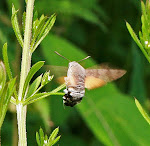The Brown Hairstreak (Thecla betulae) is only found in a quite restricted region of Britain, mainly in Oxfordshire and neighbouring counties. Like its close relative, the Black Hairstreak, it only occurs in close proximity to its larval food-plant, the Sloe.
Brown Hairstreaks are very elusive butterflies and spend most of the time high up in the trees but when the weather conditions are favourable they can come down to nectar on flowers whilst the females also descend to lay their eggs on the sloe.
Larval food-plant: the Sloe
They mainly occur in quite small, scattered populations so sightings rarely consist of more than just a few individuals.
The morning was spent at Otmoor under ideal conditions but no sightings were made (although a female had been seen and photographed here earlier in the day). A second well-known locality, Whitecross Green Wood, was visited next but again none were seen. Other people also searching had no luck either (although there were two probables very high up in a master Ash tree). So, a return was made to Otmoor for one last attempt and this was rewarded with a male perched on bramble in dense vegetation. After making such a long trip it was pleasing to have success at last although it had taken four hours of almost constant searching.
A Red Kite circling over the site at Otmoor
.jpg)
.jpg)
.jpg)
.jpg)



.jpg)
.jpg)
.jpg)
.jpg)
.jpg)
.jpg)
.jpg)
.jpg)
.jpg)

.jpg)





